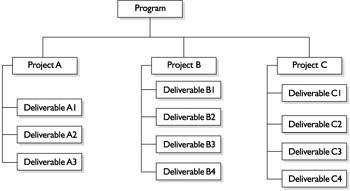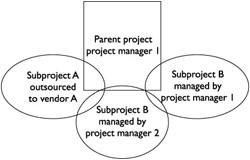Examining Related Areas of Project Management
|
| < Day Day Up > |
|
Project management is the management of activities to change the current state of an organization to a desired future state of the organization. Project management is a complex organization of decision-making, planning, implementation, control, and documentation of the experience from start to finish. In addition to traditional project management, there are related areas of project management that you may encounter, have encountered, or are actively participating in. These related endeavors often are superior to individual project management, are part of project management, or equate to less than the management of any given project.
In this section, we'll dissect the related areas of project management and see how they tie together to change a current state to a desired future state.
Program Management
Program management is the management of multiple projects all working in unison toward a common cause. Consider all of the work that could go into building a skyscraper. Within the overall work, there could potentially be several projects that lead to the end result, as demonstrated in Figure 1-2. You could have a project for the planning and design of the building. Another project could manage the legal, regulatory, and project inspections that would be required for the work to continue. Another project could be the physical construction of the building, while other projects could entail electrical wiring, elevators, plumbing, interior design, and more. Could one project manager effectively manage all of these areas of expertise? Possibly, but probably not.

Figure 1-2: Programs contain multiple projects working towards one goal.
A better solution could be to create a program that is comprised of multiple projects. Project managers would manage each of the projects within the program and report to the Program Manager. The Program Manager would ensure that all of the integrated projects worked together on schedule, on budget, and ultimately towards the completion of the program.
In other instances, the program is an ongoing effort that really does not have an end in sight. Consider the publication of a newspaper, newsletter, web site, or magazine. Essentially, the workers of these publications do the same activities for each issue, but each issue is unique and different than the last.
Another example is NASA's space program. It's a program to explore space, and is comprised of individual projects within that program. Each project under the program has its own goals, initiatives, and objectives that are in alignment with the overall mission of the space program. Programs are a collection of individual projects working in alignment towards a common end.
Case Study: Program in Action
Let's return to Zings Sweater Company. In this project, there are many tasks that could be turned into other projects. Based on your findings, you recommend that the Frequent Customer Program Project be converted into a program with a mission to increase market share by seven percent. Within this program, there are many different projects that can be established and operated by individual project managers. The project managers will work together under the guidance of the program manager to make certain that the completion of each project occurs in a logical order and in support of all the other projects.
Your company agrees that the creation of a program is a good idea and they create the following projects within the program:
-
The IT Development Project This project will create the upgrade to the retail point of sale system to support the ID tags the customers will use to obtain their discounts. This project team will create the software and databases to support the technology facet of the project. The project manager for this project will work with the program manager on budget, schedule, and integration with the other projects.
-
The Web Sales Project Your company's web site, www.zingsweaters.com, does not currently have an e-commerce enabled utility. Customers can visit the site and see the catalog of sweaters, but they cannot make purchases online. This project will create a new web presence to allow customers to surf and purchase sweaters online and participate in the Frequent Customer Program.
-
The Frequent Customer Program Training Project This project will create training documentation, videos, and a web presence for internal training of how the new point of sale software, the ID tags, and the Frequent Customer Program will work to better the company. The training process will take 20 minutes to complete through the web-based training (WBT) application. The training for the retail managers will take one hour to complete through the WBT application. The documentation of how to use the point of sale software will be located at each register in the retail locations for quick reference.
-
The Manufacturing Upgrade Project The equipment used to create the wonderful Zings Sweaters will need to be upgraded in order to support the new demand of anticipated sales. This project will oversee the adjustment and fine-tuning of current equipment and the installation of two additional machines on the shop floor. The assigned project manager will work closely with the Director of Manufacturing and the Manufacturing Plant Manager in the procurement of the new equipment. In addition, there will be strong ties to the financial benefits of the new equipment, and the success of the other projects under this program.
-
The Customer Marketing Project In order for this project to be successful, customers will need to know about the new Frequent Customer Program. This project will work with writers and designers to create a flashy campaign that will drive sales at both the retail stores and the web site. In addition, the project will recruit customers into the program by offering a ten-percent discount on any sweaters purchased when they join.
Subproject Implementation
Subprojects are an alternative to programs. Some projects may not be wieldy enough to require the creation of a full-blown program, yet still be large enough that some of the work can be delegated to a subproject. A subproject exists under the parent project, but follows its own schedule to completion. Subprojects may be outsourced, assigned to other project managers, or managed by the parent project manager but with a different project team. The following illustration shows a project containing multiple subprojects.

Subprojects are often areas of a project that are outsourced to vendors. For example, if you were managing a project to create a new sound system for home theaters, a subproject could be the development of the user manual included with the sound system. You'd hire writers and graphic designers to work with your project team. The writers and designers would learn all about the sound system and then retreat to their own space to create the user manual according to their project methodology. The deliverable of their subproject would be included in your overall project plan, but the actual work to complete the manual would not be in your plan. You'd simply allot the funds and time required by the writers and graphic designers to create the manual.
Subprojects do, however, follow the same quality guidelines and expectations of the overall project. The project manager has to work with the subproject team regarding scheduling, value, and cost to ensure the deliverables and activities of the subproject integrate smoothly with the 'master' project.
Project Portfolio Management
Have you ever had a fantastic idea to implement a new technology, design a new product or service, or other project only to have it discarded by management? Most organizations, big and small, only have so much cash to invest in new projects.
Project Portfolio Management is a management process to select the projects that should be invested in. Specifically, it is the selection process based on the need, profitability, and affordability of the proposed projects. As you probably already know, not all proposed projects can realistically be implemented. Some projects cost too much, while others may not meet a required level of return on investment. The selection of projects can often be a political and gut-wrenching process. The planning process and the project initiation phase of a project allows a project to prove its worth.
Some projects, while valuable, still don't come into play for several reasons. One of the most obvious could be lack of money to implement the proposed project. Or there may already be too many investments in other projects. Or perhaps a lack of internal resources may require that the proposed project be shelved until a later date.
|
| < Day Day Up > |
|
EAN: 2147483647
Pages: 209